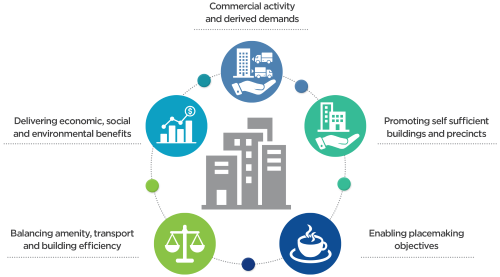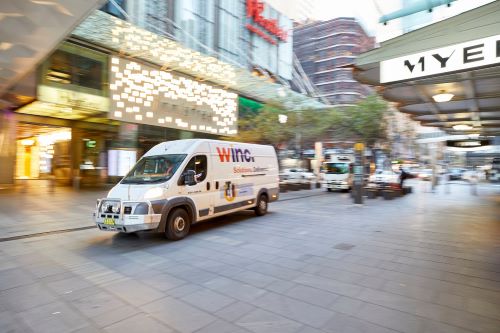Guiding Principles
There are five key guiding principles for planning freight and servicing activity in urban centres with high-density land uses:

Commercial activity and derived demand
There is no direct demand for the transport service itself, rather the demand is for the good or service being transported. This means planners designing buildings and precincts must be aware of the demand for the vehicle movements these developments are likely to generate. In the past, plans for new developments and precincts have not always taken this demand into account.
Promoting self-sufficient buildings and precincts
Nearly every building or precinct will generate private and commercial vehicle trips. The number and type of these vehicle movements will depend on the land use and placemaking objectives. As vehicles travel to and from buildings or precincts and dwell at kerbsides, they generate direct costs due to road wear, and secondary costs due to congestion and pollution. The obvious solution is to ensure buildings and precincts have enough on-site, off-street capacity to accommodate the freight and servicing vehicle movements their demand generates and effectively become self-sufficient.
Enabling placemaking objectives
Freight and servicing movements are often regarded as a risk to safety, amenity and placemaking objectives due to shared spaces with other users such as pedestrians and cyclists as well as visual, noise and air pollution. This can be exacerbated by planning and management approaches to freight and servicing developed after the key design parameters of buildings and precincts have been decided. Fully appreciating and actively planning for the transport task is the most effective way to ensure it enables good place and amenity outcomes in a building or precinct.
Balancing amenity, transport and building efficiency
An effective planning framework balances the needs of safety, amenity and placemaking outcomes with freight and servicing operational requirements. To achieve this, planners and developers need to incorporate freight and servicing considerations into their designs for both new and existing buildings and precincts. It is equally important they ensure that this is not done in isolation of the surrounding environment.
Delivering economic, social and environmental benefits
Freight and Servicing movements generated by buildings and precincts affect the efficiency of the greater transport network. While an individual building or precinct’s impact may be modest, the cumulative impact of buildings and precincts is more significant, both on the streets surrounding individual sites and for the broader network. Planning and approving authorities have an opportunity to secure economic, social and environmental benefits by ensuring that freight and servicing vehicle movements are well-planned and well-managed by:
- enabling the use of the most efficient vehicle types
- minimising vehicle movements
- facilitating consolidation to minimise total journeys
- encouraging out-of-peak movements and providing alternative last mile delivery options.
